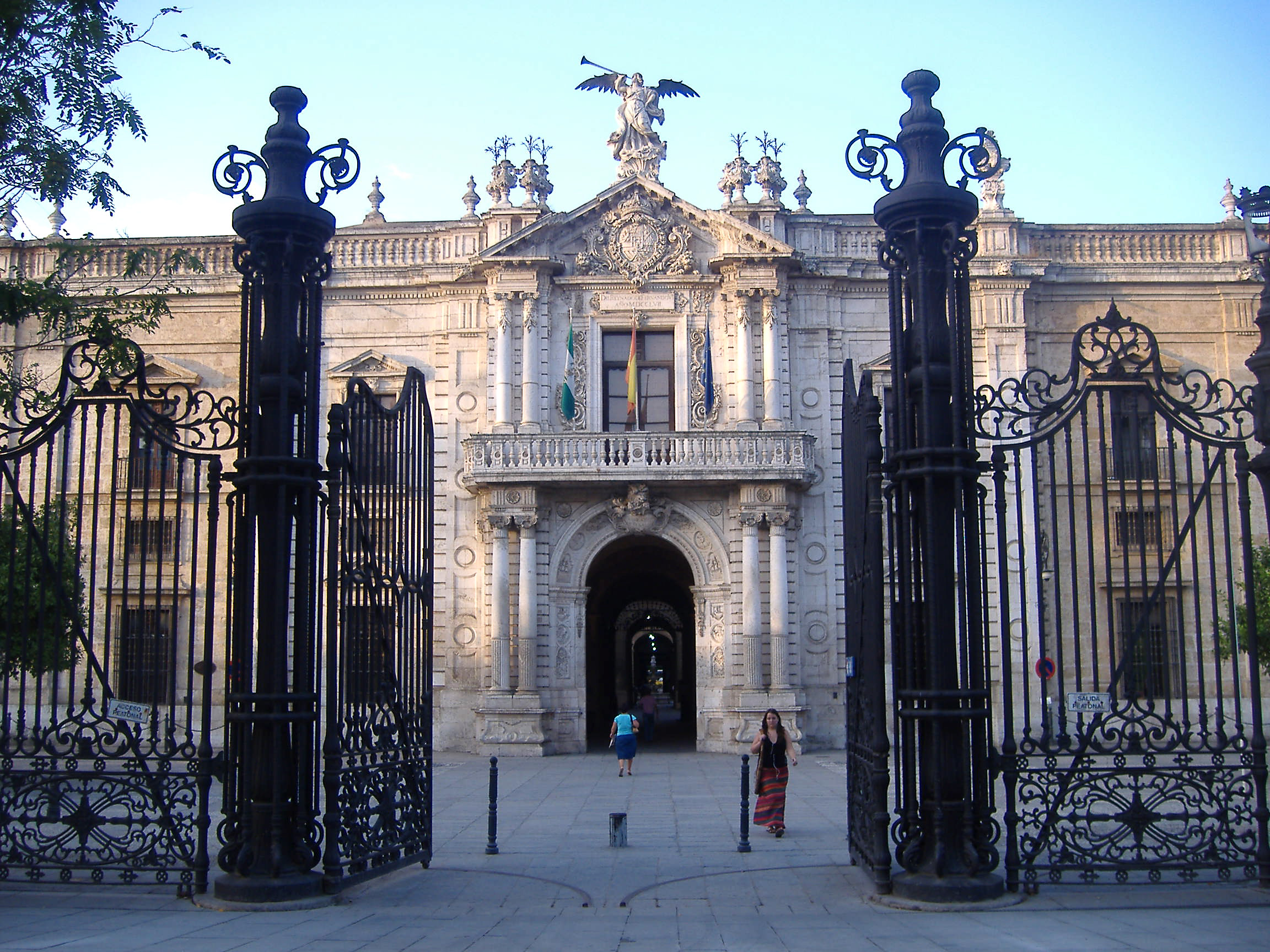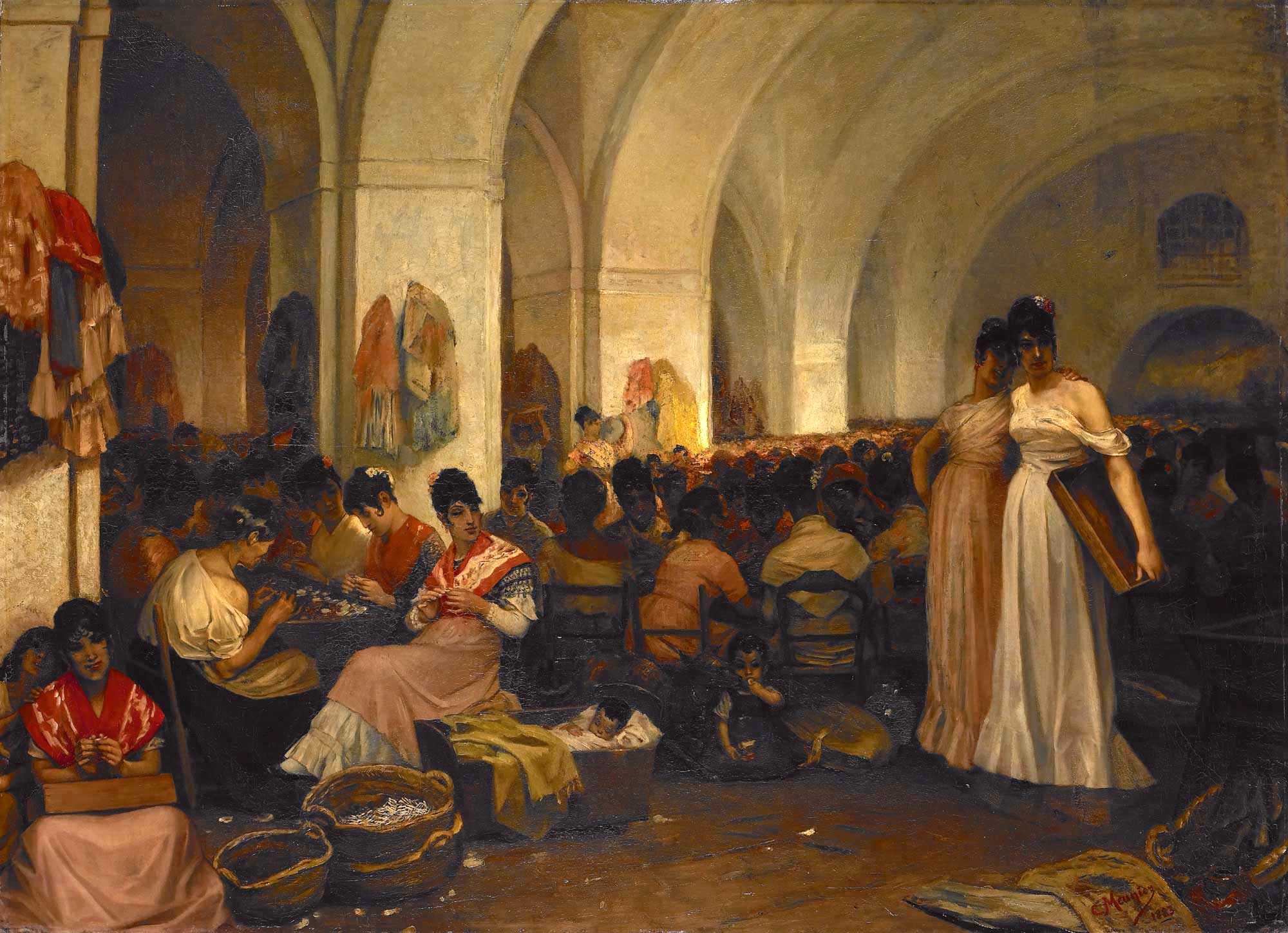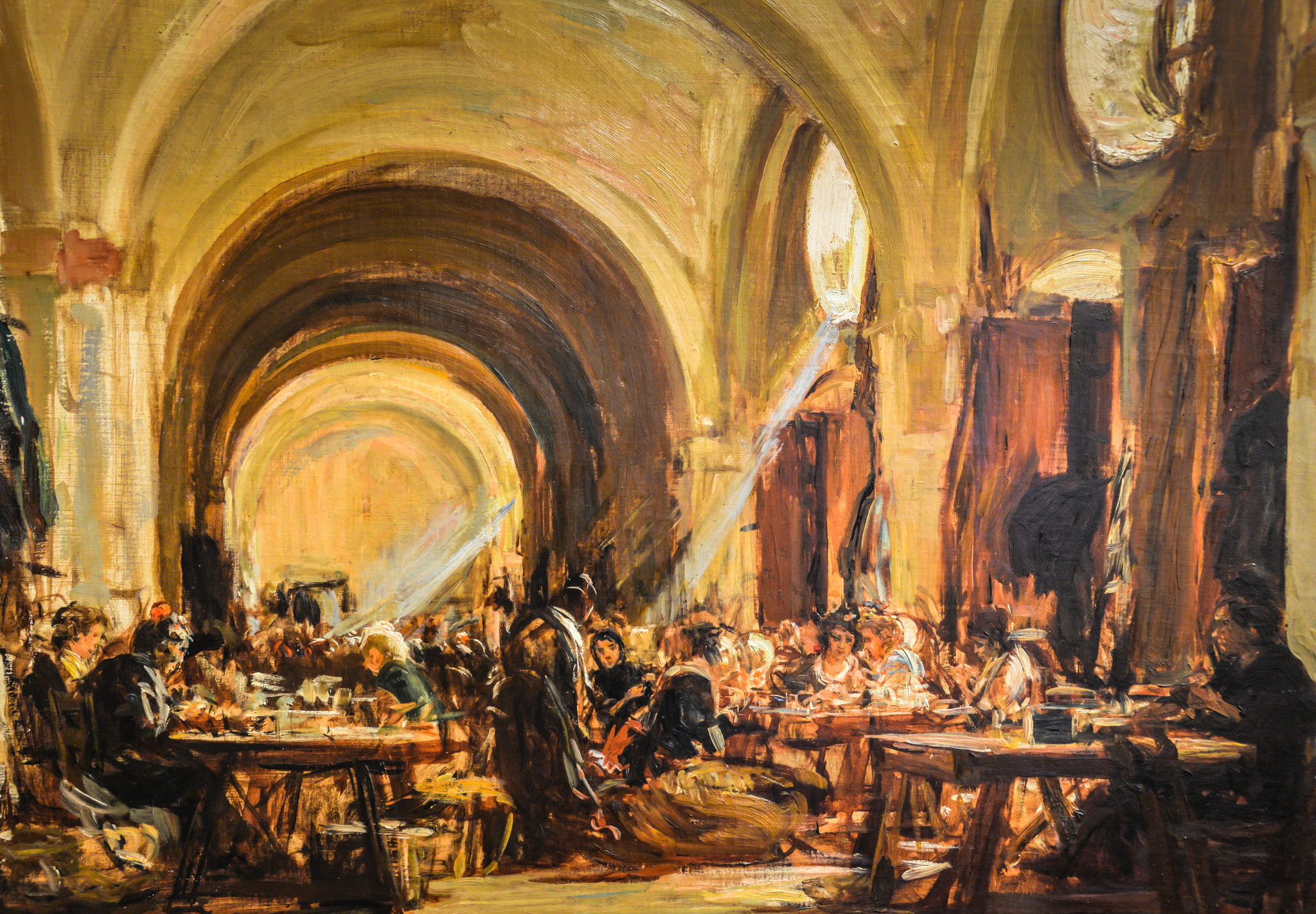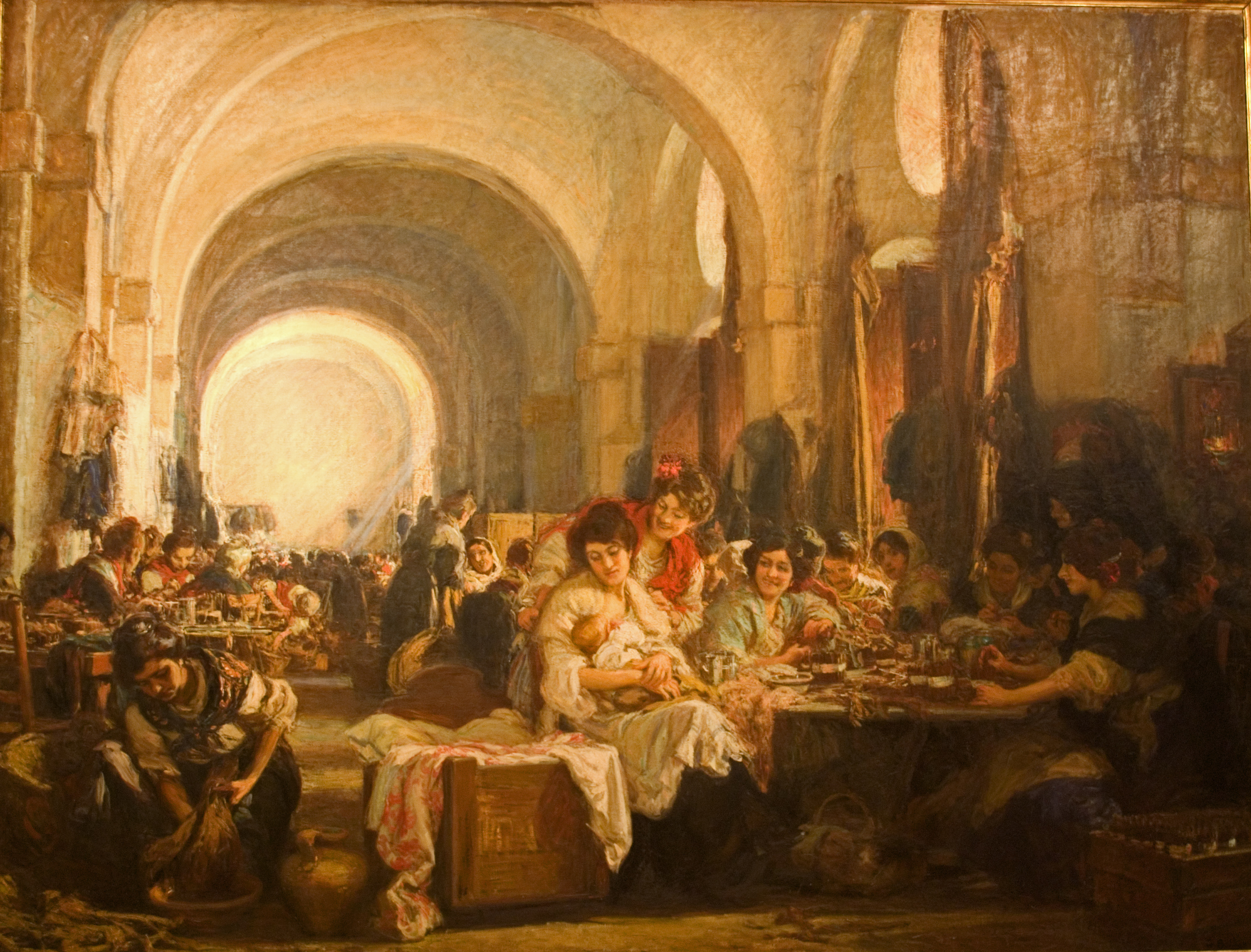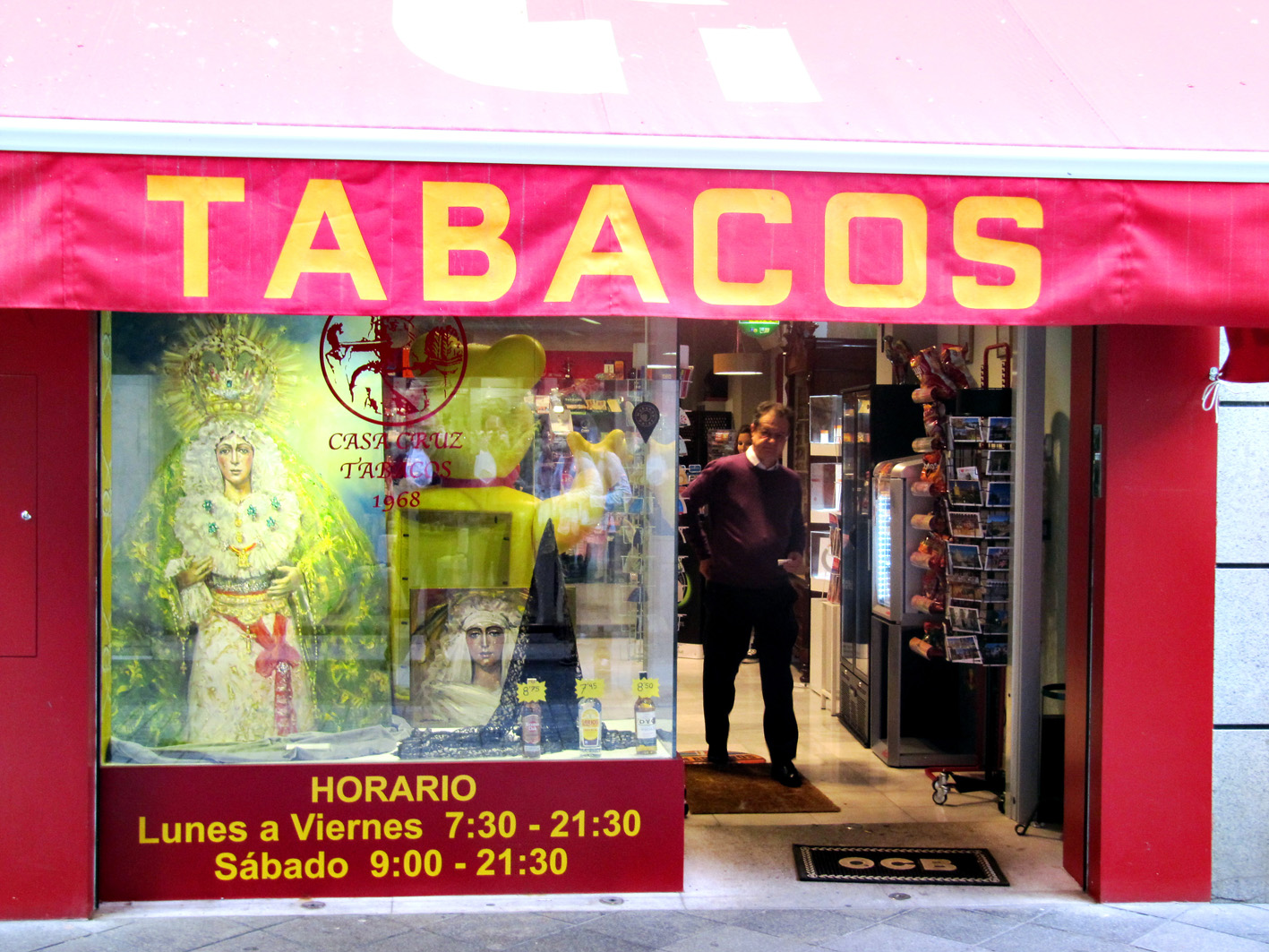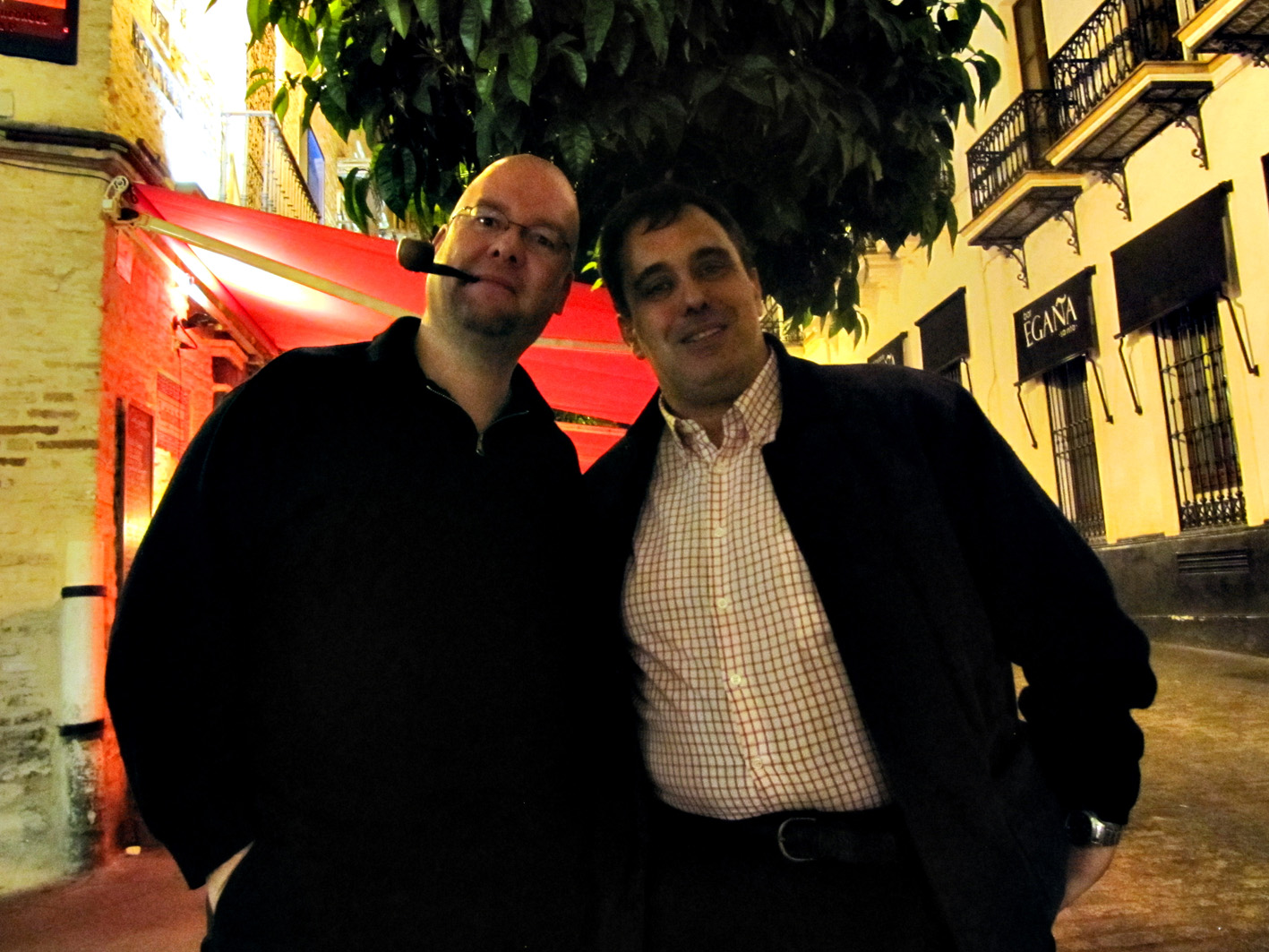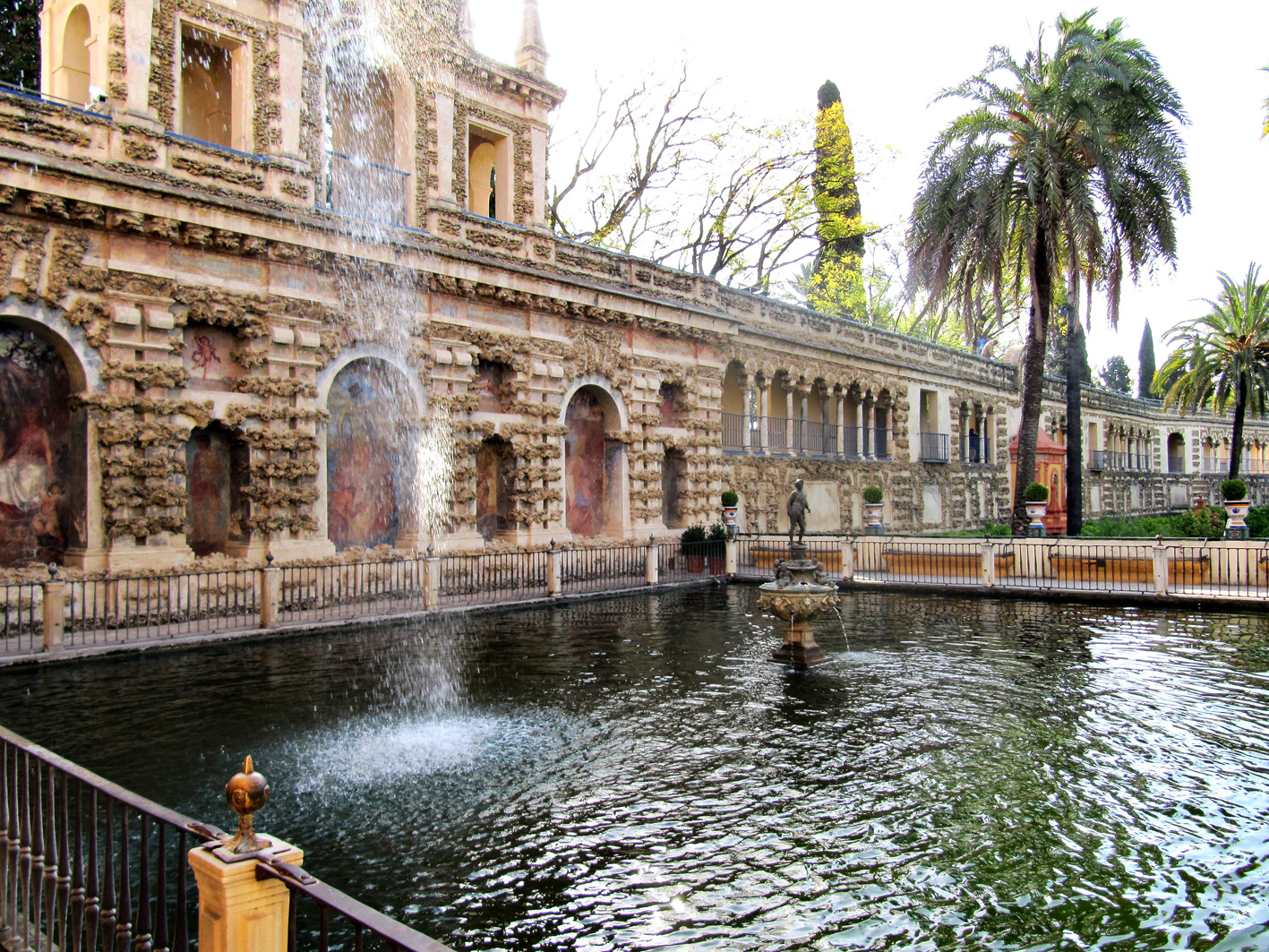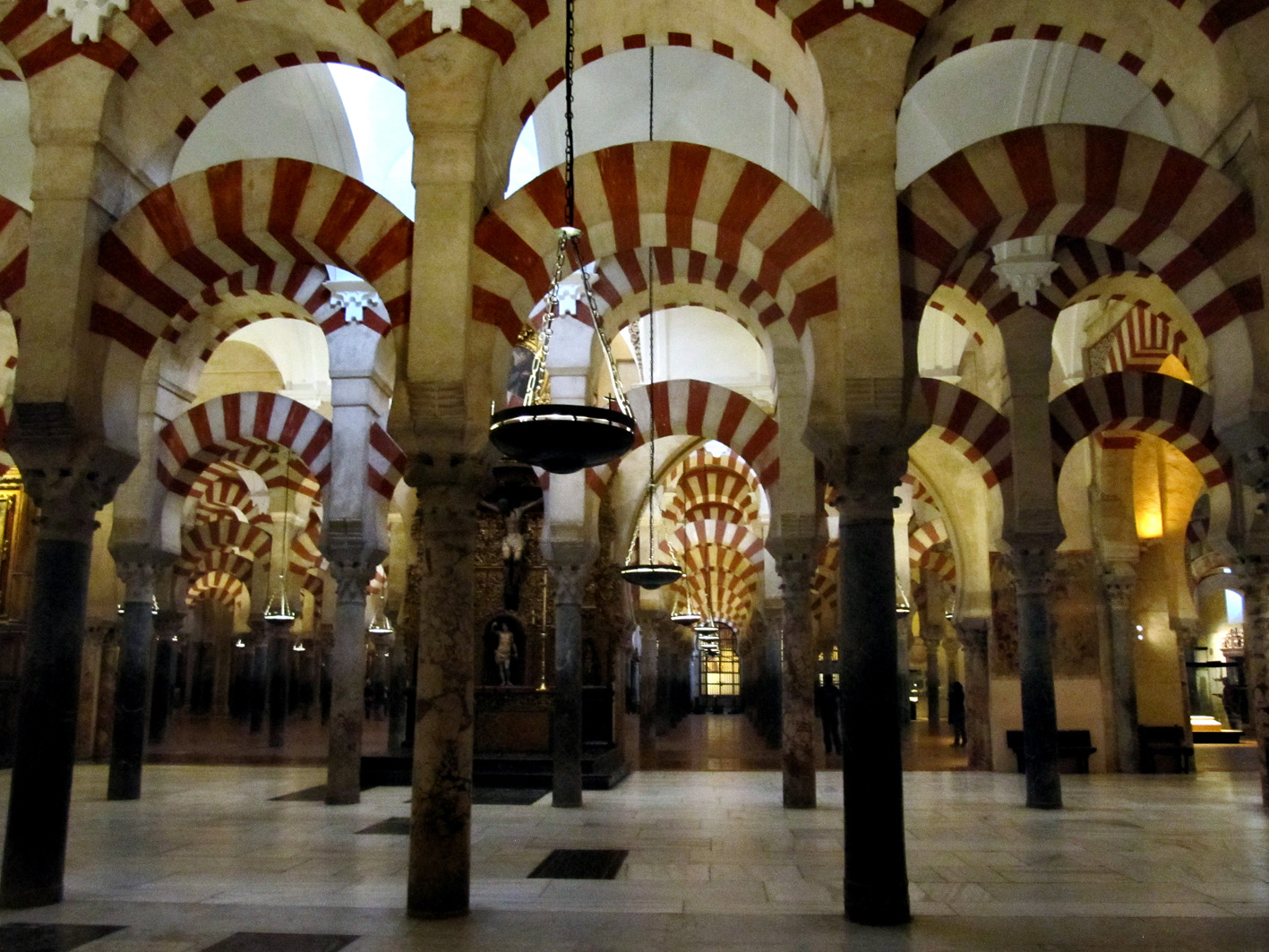Click here for part 1 which describes the history of Seville and how it became the tobacco capital of the world.
 For me visiting the Real Fábrica de Tabacos (Royal Tobacco Factory) was a highlight of my journey to Seville. Today a part of the renowned Seville University is located there. Unfortunately the interior has been renovated and “no smoking” signs are everywhere. But until 1959 this magnificent building was Spain’s, no, Europe’s powerhouse for the manufacturing of tobacco. It is also the inspiration and setting for Seville’s most renowned fictional heroine, the free-spirited gypsy girl who embodies the Spanish ideal of the sensual femme fatale: Carmen.
For me visiting the Real Fábrica de Tabacos (Royal Tobacco Factory) was a highlight of my journey to Seville. Today a part of the renowned Seville University is located there. Unfortunately the interior has been renovated and “no smoking” signs are everywhere. But until 1959 this magnificent building was Spain’s, no, Europe’s powerhouse for the manufacturing of tobacco. It is also the inspiration and setting for Seville’s most renowned fictional heroine, the free-spirited gypsy girl who embodies the Spanish ideal of the sensual femme fatale: Carmen.
The Real Fábrica de Tabacos was built between 1728 and 1770 and was designed and supervised by several military engineers from the North of Spain and The Netherlands. The works were abandoned for a long period (1735 – 1750) due to financial troubles (the initial budget was clearly not enough) and because the engineers and architects in charge were not fully committed. Its huge size (rectangular area of 27,195 square meter or 292,725 square feet) is just smaller than the mighty El Escorial located near Madrid. With a mixture of architectonic styles the building is divided into 2 areas. One devoted to the tobacco process and a smaller one that included the entrance, offices, depots and apartments for the superintendent and the director.
The factory was officially inaugurated in 1757 even though the building was not yet completed. Unfortunately, the factory was already out of date by then. It had been designed for the making of snuff, but during those 30 years the export demand for cigars increased and demand was equally high in the domestic market. The shift away from snuff production made a bigger labour force necessary. Cigars could not be ground out by the hundredweight but had to be assembled and rolled individually.
Before 1800 all the Fábrica’s workers had been men because making snuff was heavy work. But these proved to be too clumsy and slow for cigar-making. In 1813 the Fábrica came with a solution by employing single women, whose fingers were nimbler and who would accept a lower wage than men with families to support. The Fábrica recruited its new workforce from the young women of the Triana district. Seville is a hellish furnace in summer and the Triana girls, many of whom were gypsies, were reduced by the heat to working in their underwear. Even hotter became the well-bred European men who visited the factory in search of sexual thrills: This immense harem of four thousand eight hundred women is as free in speech as in words. They showed no reserve in profiting by the tolerance which permits them undress as much as they like in the insupportable atmosphere they live in from June to September. Almost all worked stark naked to the waist with a simple linen petticoat unfastened round it and sometimes turned up as far as the middle of the thighs. And they presented an extraordinary mixture. There was everything in this naked crowd, virgins excepted, probably.
The so called “cigarreras” prepared and rolled the tobacco leaf into cigars, chopped, rolled and ground it for pipe tobacco or snuff and made cigarettes rolled in paper. Cigarettes were initially considered a humble by-product, improvised by the factory girls to enable them to smoke discarded scraps from cigar production. The leaves were dried in special ovens that demanded a constant temperature and humidity apparently was secured by a system of subterranean waterways. The workforce was organized in a sophisticated hierarchy. Ranging from apprentices who started work at the early age of 13, peeling the stalks from the leaves, until (under the watchful eye of a veteran) they perfected the art of “making the baby”, rolling a cigar with the delicacy and precision of a midwife wrapping a new-born child. The aristocrat of this noble profession was the purera or maker of puros (cigars), who received top wages. But by far the majority of the women workers were employed in the humbler, poorer-paid, tasks of making cigarettes and pipe tobacco.
The right to bring babies into the factory was one of the important early victories of the cigarreras labour struggles. These feisty women were pioneers of European trade union rights. The factory even provided high-sided, wooden cradles that the mothers could rock with their foot without having to interrupt their work. Other victories achieved were the 8-hour workday, retirement pensions, working clothes and the custom of respecting the preferences of workers nearing retirement. The only inflexible rule was the absolute prohibition on stealing tobacco. This prompted the much remarked-upon personal searches that each cigarrera had to undergo. However, some were creative and hid the tobacco in a place his Catholic Majesty would have never dreamed of.
But by 1918, it was all over. The United States seized control of the world’s tobacco trade and both the economic reality and mythic reputation of Seville’s tobacco factory entered into decline. New machines improved the process and the cigarreras were replaced. In 1950 it was decided to move the tobacco operations to the Los Remedios neighbourhood and to use the historic building as the headquarters of the University of Seville. The replacement factory built in the 1950’s remained part of Spain’s national tobacco monopoly Tabacalera until that was merged into Altadis in 1999. In 2004, Altadis announced plans to shut the plant in 2007, bringing to an end Seville’s long tradition of making tobacco products. The last day of operation of the factory was 31 December 2007.
 In Spain tobacco is sold in shops called “expendeduría de tabaco y timbre” or “estanco”. You can find them anywhere, small and big, and are recognizable by a big banner with “Tabacos” on it. Compared to many European countries tobacco here is still cheap. Still, yes, because prices are rising rapidly because of the taxes. Despite that you pay for example for a tin of Samuel Gawith Squadron Leader €8, in Germany the current price is €12,85. But the assortment of pipe-tobacco differs greatly from estanco to estanco. So I decided to get some local help. After a bit of Googling I stumbled upon the Andalucía Pipa Club and mailed them about my upcoming journey to Seville and if they knew some good tobacconists in the city. I got a reply from the very friendly and helpful Alfonso who lives in Seville and immediately provided me with lots of information.
In Spain tobacco is sold in shops called “expendeduría de tabaco y timbre” or “estanco”. You can find them anywhere, small and big, and are recognizable by a big banner with “Tabacos” on it. Compared to many European countries tobacco here is still cheap. Still, yes, because prices are rising rapidly because of the taxes. Despite that you pay for example for a tin of Samuel Gawith Squadron Leader €8, in Germany the current price is €12,85. But the assortment of pipe-tobacco differs greatly from estanco to estanco. So I decided to get some local help. After a bit of Googling I stumbled upon the Andalucía Pipa Club and mailed them about my upcoming journey to Seville and if they knew some good tobacconists in the city. I got a reply from the very friendly and helpful Alfonso who lives in Seville and immediately provided me with lots of information.
The best places to buy pipe-tobacco in Seville are:
– The estanco at the Calle O’Donnell 30B. Google Maps is not accurate, just look for a big sun screen with “Tabacos” on it. This shop has the best assortment of pipe-tobacco in Seville. Basically everything from this list (Scroll to “picadura de pipa”). Just one thing, I had to point out the tins I wanted to the young employee to the amusement of the other customers.. Samuel Gawith? Qué?
– The estanco at the Calle Lineros 11B (Palacio del fumador). More focused at cigars but a lot of pipes and a decent assortment of pipe-tobacco.
– The estanco at Expendeduria 113. Not in the city centre, not so many brands as the first one, but more focused at specialities.
BEWARE: Spanish airport customs are very strict. My bag got searched and they counted the weight from all my tobacco tins, the ones I bought and the ones I brought with me from home. If you live within Europe you may take 1 kilo of tobacco with you and if you come from outside Europe even less.. Also be sure to keep your receipt if you buy tobacco in Spain. When you can’t show it if the customs officer asks for it all tobacco will be confiscated. Luckily all my tins could come with me.
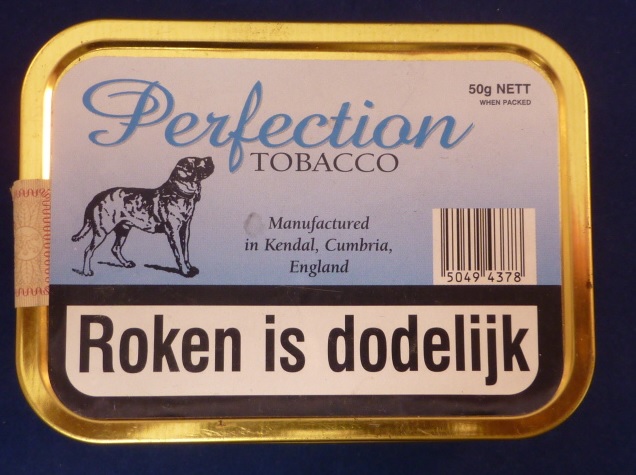 I also got some very useful tips where to eat and drink from Alfonso and asked him if there were places where I could smoke inside. He had to laugh: No problems for smoking your pipe because almost every bar/restaurant/café in Seville has a terrace. That’s the way of life in Seville: if we are living in a sunny city… Why we should stay inside a building? Good point.. We kept on mailing and he told me a story that he on a trip to Amsterdam got conned by a Dutch tobacconist. He paid €25 for 1 tin of Samuel Gawith Perfection! I mean, tobacco is expensive here but that amount was outrageous and nowhere near correct.
I also got some very useful tips where to eat and drink from Alfonso and asked him if there were places where I could smoke inside. He had to laugh: No problems for smoking your pipe because almost every bar/restaurant/café in Seville has a terrace. That’s the way of life in Seville: if we are living in a sunny city… Why we should stay inside a building? Good point.. We kept on mailing and he told me a story that he on a trip to Amsterdam got conned by a Dutch tobacconist. He paid €25 for 1 tin of Samuel Gawith Perfection! I mean, tobacco is expensive here but that amount was outrageous and nowhere near correct.
We also decided that we had to see each other when I was in Seville. So after a couple of text messages Ellen, Alfonso and I arranged to meet at the splendid Puerta del Pérdon near where we were staying. I put a corncob pipe in my mouth so Alfonso could recognize me but that was not necessary. I saw him first, puffing away under the great gate. We met like we were lost brothers, it really felt that way for me. We opted to go to the terrace of a nearby restaurant Alfonso knew. A bit tourist but Alfonso swore to me the drinks and food were excellent. We sat down and I said I had a present for him. I pulled out an aged tin of Samuel Gawith Perfection to compensate for the Dutch con. Alfonso laughed and thanked me, but he also had a surprise for me. The Andalucía Pipa Club had a blend made by Samuel Gawith: a limited, special edition of Squadron Leader containing perique. And precisely that was what he gave me, wonderful!
Time flies by when you are having fun, we chatted away and were even joined by Alfonso’s charming wife Macarena. They let us try local drinks and foods like shrimps in garlic, Jamón ibérico and deliciously sweet desserts. At the end of the magical evening I wanted to call the funny waiter (he had to serve the terrace alone and was so busy he forgot us several times which resulted in apologies in rapid Spanish and some free drinks) to get the bill but discovered Alfonso and Macarena already paid it. They gently refused my money and just said with big smiles: Welcome to Seville! Once again I thank them both for this unforgettable experience! Gracias!
To round off this blogpost, here are some tips from my own (short) experience about Seville:
– Hotels can be pretty expensive, especially near the old city centre. But thanks to AirBnB I found a small but delightful penthouse apartment, literally a stone-throw away from the cathedral, with an excellent price-quality ratio.
– Visit the large Seville Cathedral where the remains of Christopher Columbus are buried and climb the ancient Giralda tower for a stunning view of the city.
– Visit the Royal Alcázar of Seville which is one of most beautiful palaces in Spain and the oldest one still in use in Europe. A part of season 5 of Game of Thrones was shot there. Also marvel at the heavenly, lush gardens which are a blend of Moorish, Renaissance, and English traditions.
– Visit the Real Fábrica de Tabacos. Duh!!!
– Visit the famous Plaza de España, where movies like Star Wars and Lawrence of Arabia were shot.
– Stroll along the Guadalquivir River and pay a visit to the old Torre del Oro.
– Visit the neighbourhood of Triana. It played an important role in the history of the city and is a folk, monumental and cultural center. If you want to see flamenco, go here.
– Wander through and get lost in the small streets of Santa Cruz where around every corner is a new wonder.
– Make a day-trip with the AVE high-speed train to Córdoba and visit one of the most awesome sights Spain has to offer: The Mezquita, the more than a millennium old mosque-cathedral, crowning glory of Muslim architecture in the West. In its heyday, a pilgrimage to the great Mezquita by a Muslim was said to have equalled a journey to Mecca. When you are done drooling in the mosque-cathedral you can re-fill your body-fluids at the enchanting Salón de Té.
– Eat tapas! These little wonders of gastronomy are cheap and oh so yummie! Just order them randomly and find out what you like. Good places (but there are many, many more) are La Hostería del Laurel, one of the locations in Don Juan and Bodega Santa Cruz, better known as Las Columnas. I especially grew very fond of the latter, cheap and basic tapas but very delicious. Especially in combination with a tinto de verano or a local Cruzcampo beer. And a tip from Alfonso: If you find a bar/restaurant with too much tourism and no locals, or they are offering “real Paella”… It’s a trap!
After a long journey home (no thanks to the Dutch railways) Ellen and I came to the conclusion that Seville certainly had not forsaken us. Olé!!!
A part of the 2003 movie Carmen, filmed at the actual Real Fábrica de Tabacos!

